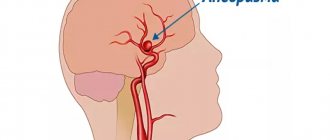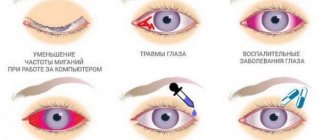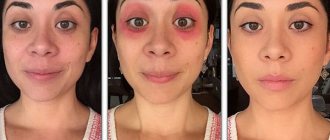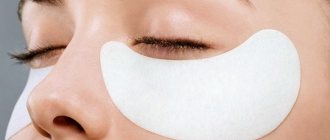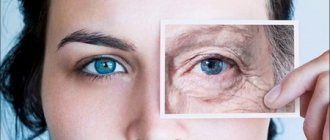Due to its anatomical features, the skin around the eyes is most susceptible to environmental factors and allergens that enter the body. The reaction to an external or internal stimulus manifests itself almost instantly, expressed in swelling. Swelling of the eyes due to allergies, which develops in adults and children, causes discomfort and causes concern. What measures should be taken, and is there a way to prevent the pathological phenomenon?
Allergens
More than 20 thousand allergens are known. They are not inherently dangerous. But if the immune response is incorrect, they cause a complex of allergic manifestations.
The most common causes of allergies are:
- medications (antibiotics, vitamins);
- insect bites (bees, gadflies);
- animal hair;
- pollen;
- household detergents;
- cosmetics, perfume;
- food products (chocolate, honey, citrus fruits, nuts);
- dust, bed mites.
You will learn more about the mechanism of the pathological process and symptoms from the video:
What caused it: reasons
Allergic swelling of the eyelid of one eye or both visual organs is a fairly common problem not only among adult patients, but the problem is often diagnosed in children. The deviation is associated with allergies, which are an enhanced immune response to certain irritants. In some patients, allergic swelling in the eye area is noticeable only in the first half of the day and is not so pronounced. Other patients experience severe swelling that prevents them from seeing normally. The severity of the pathological process depends primarily on the immune system and the allergen. In children and adults, allergic edema in one eye or both organs of vision can occur under the influence of the following substances and factors:
Eye irritation is the body's reaction to seasonal allergens.
- plant pollen;
- high pressure inside the skull;
- taking certain foods that contain an allergen;
- long bathing;
- prolonged exposure to the open sun;
- freshly cut grass;
- impaired functioning of the kidneys and urinary organs;
- mites under the skin;
- constant presence at the computer or TV;
- intestinal dysbiosis;
- excessive fluid intake;
- barley formation;
- gastrointestinal dysfunction;
- a bite of an insect;
- dust;
- pet fur.
Women often suffer from allergic edema caused by the use of low-quality cosmetics.
Clinical manifestations
An allergen is an antigen, in response to which antibodies are formed. Antibodies combine with the antigen to form immune complexes. As they circulate in the body, they damage mast cells. Inflammatory mediators are released, the action of which leads to clinical manifestations.
With allergic swelling of the eyes, severe itching, burning, and swelling of the subcutaneous tissue occur. The eyes begin to water, photophobia appears. With allergic edema of the eyelid, the skin becomes pale and may become red due to scratching or rashes. Characterized by the absence of pain.
Symptoms can develop at lightning speed in a matter of seconds, or they can increase gradually. Swelling of the eyelids due to allergies can manifest itself in the form of:
- allergic conjunctivitis;
- Quincke's edema involving the eye.
Quincke's edema is angioedema of the skin, subcutaneous tissue, and mucous membranes. It manifests itself as severe swelling of the eyelids, throat, tongue, lips. It is a life-threatening condition.
Allergic conjunctivitis is not life-threatening and is manifested by intense itching, lacrimation, redness of the mucous membrane, and slight swelling of the eyelids.
Hyperreactive reactions occur more often in children. This occurs due to the incomplete development of the immune system. Allergic swelling of the eye in a child manifests itself with the same symptoms as in adults.
Prevention
What to do to reduce the risk of allergic conjunctivitis.
- Wear sunglasses when you go outside. They will mechanically prevent the allergen from getting into the eyes.
- If you suspect contact with an allergen, rinse your eyes with running water for several minutes.
- Use “artificial tears” to moisturize the cornea, this increases its protective properties and, in addition, removes allergens from the surface.
- Remove contact lenses if you feel discomfort from wearing them.
- Do not rub your eyes, no matter how itchy they may be. This will only increase irritation.
- Try to secure your home during the flowering season: close the windows, do wet cleaning more often, buy an air purifier.
- Avoid exposure to harsh chemicals, choose cosmetics without fragrances or dyes.
- Call your doctor right away if you develop severe eye pain or vision loss.
Allergic conjunctivitis in a child can only be treated by a doctor, since most drugs are not intended for use in pediatrics and have age restrictions: loratadine, cetirizine - up to two years, azelastine, clemastine - up to six years, fexofenadine up to 12 years of age.
Diagnostics
An ophthalmologist, a therapist (pediatrician for children), and an allergist can examine allergic angioedema of the eyelids and allergic conjunctivitis.
The diagnosis is made after examining and questioning the patient. There is a clear relationship between the appearance of allergic swelling and exposure to the allergen.
A general blood test is needed to determine eosinophils - cells whose number increases during allergies.
Sometimes allergic conjunctivitis is similar in clinical manifestations to conjunctivitis of an infectious nature. The difference between infectious inflammation of the mucous membrane is purulent discharge from the eyes. For differential diagnosis, the doctor takes a scraping from the conjunctiva to determine the presence of the pathogen.
To exclude other diseases or a foreign body, the ophthalmologist examines the eyes from the outside and using a slit lamp. To determine eosinophils, tear fluid is taken for examination.
An allergist performs tests to determine the allergen. Sometimes the allergen cannot be identified. Even an experienced allergist is powerless. In such situations, it is necessary to carry antihistamines with you at all times and teach loved ones what to do if symptoms appear.
Examination for swelling of the eyelids
Anamnesis. Collecting an anamnesis of the disease includes clarifying the following questions: when the edema developed, the unilateral or bilateral nature of the process, the presence or absence of previous injuries (including insect bites). Key symptoms: itching, pain, headache, changes in visual acuity, fever, presence of discharge from the eye.
When examining other systems, it is necessary to pay attention to the symptoms of possible causes of eyelid swelling: runny nose, itching, rash, shortness of breath (systemic allergic reactions); headache, nasal congestion, purulent discharge from the nose (sinusitis); toothache (oral infection); dyspnea, orthopnea, paroxysmal nocturnal dyspnea, heart failure); intolerance to low temperatures, skin changes (hypothyroidism); intolerance to high temperatures, anxiety, weight loss (hyperthyroidism). Collecting a life history includes clarifying the following questions: the presence of previous eye trauma, ophthalmological operations, the presence of diseases of the heart, liver, kidneys, thyroid gland, allergies, contact with possible allergens and the use of ACE inhibitors
Collecting a life history includes clarifying the following questions: the presence of previous eye trauma, ophthalmological operations, the presence of heart disease, liver, kidney, thyroid disease, allergies, contact with possible allergens and the use of ACE inhibitors.
Physical examination. Assessment of general condition indicators (fever, tachycardia).
During an ophthalmological examination, it is necessary to evaluate the following parameters: localization and extent of edema (unilateral or bilateral; upper and/or lower eyelid), the presence of hyperemia, local increase in temperature and pain. It is necessary to evaluate whether these symptoms are a sign of swelling of the eyelids, protrusion of the eyeball (exophthalmos), or a combination of these conditions
Particular attention should be paid to visual acuity and range of movement of the eyeballs (full or limited). In cases of severe edema, examination may be difficult, but it is necessary because
allows you to differentiate eyelid lesions from orbital or retro-orbital pathology; in some cases, the help of an assistant may be necessary. It is necessary to evaluate the conjunctival injection and the presence of discharge from the eyeball. The examination is performed using a slit lamp.
During a general examination, it is necessary to assess the presence of symptoms of intoxication, suggesting a systemic infection, as well as symptoms of the primary disease
It is necessary to pay attention to the condition of the skin: dryness, peeling (hypothyroidism); oily scales (seborrheic dermatitis). Swelling of the extremities or sacrococcygeal region indicates systemic disorders
Alarming symptoms. Warning symptoms include:
- fever;
- decreased visual acuity;
- difficulty moving the eyeballs;
- exophthalmos.
Interpretation of research results. Specialized studies help to make a differential diagnosis between different groups of diseases, for example, between inflammation, infection, allergic reaction, hypervolemia. Pain, redness, local hyperthermia, and tenderness suggest inflammation or infection, while absence of pain and pale skin are consistent with angioedema. The presence of itching suggests an allergic reaction, while in pathologies of the heart and kidneys no itching is observed.
Swelling limited to one eyelid, in the absence of other symptoms, rarely indicates serious illness. An alarming symptom is pronounced swelling of both the upper and lower eyelids (unilateral or bilateral). Symptoms such as exophthalmos, decreased visual acuity, difficulty moving the eyeballs, and signs of inflammation indicate orbital diseases. These diseases may cause exophthalmos, damage to muscles and nerves.
How to quickly remove allergic swelling from the eyes: first aid
You need to start providing first aid when the first signs appear. It is aimed at stopping contact with provoking factors, reducing the concentration of allergen in the blood, and blocking inflammatory mediators.
Before the ambulance arrives at home you need to:
- eliminate the allergen;
- take an antiallergic drug: “Suprastin”, “Diazolin”, “Tavegil”;
- to drink a lot of water;
- Apply cotton pads soaked in cool water to your eyelids.
It is not recommended to make lotions or washes with herbs. Plant components may turn out to be additional provocateurs, which will aggravate the situation.
Allergic swelling of the eye: what to do
Medical assistance is mandatory in these situations:
- a combination of swelling of the eyelids with swelling of the lips and throat;
- breathing problems, suffocation;
- if the child's eyes are swollen due to allergies;
- manifestation of swelling in pregnant or lactating women.
Therapy consists of prescribing antihistamines. For allergic conjunctivitis, the use of drops and tablets is sufficient.
For more severe allergies, injectable forms of antihistamines and hormonal drugs will quickly help relieve swelling of the eyes. These groups of drugs block the action of damaging substances, inhibit the hyperreactive response of the immune system, which leads to a rapid reduction in tissue swelling and itching.
Moisturizing drops have a protective effect and a vasoconstrictor effect. This helps cope with redness, reduces swelling, and protects the mucous membrane.
Enterosorbents are prescribed to bind and remove allergens. 1.5–2 hours before and after taking enterosorbents, you should not take other drugs, as their absorption will worsen.
- Antihistamine eye drops: “Allergodil”, “Lecrolin”, “Cromohexal”, “Opatanol”; tablets and solutions for injections: “Suprastin”, “Tavegil”.
- Moisturizing drops: “Vizin”, “Slezin”.
- Hormonal solutions for injection, eye drops and ointments: ointments for external use “Advantan”, “Hydrocortisone”; Dexamethasone eye drops; solutions for injections: “Prednisolone”, “Dexamethasone”.
- Enterosorbents: “Enterosgel”, “Polysorb”, “Smecta”.
You shouldn’t choose what to use to relieve puffiness under your eyes. Medicines have contraindications and side effects. For any manifestation of allergic edema, it is recommended to seek medical help, as serious complications are possible.
The video talks about common allergens, diagnostic methods, and treatment.
Treatment
Treatment of allergic edema should be carried out as soon as possible from the time of diagnosis. Since allergic reactions usually increase in severity, over time the swelling can spread to the nasopharynx, which is unsafe for the patient’s life.
Antiallergic drugs for internal use
It is customary to treat allergic conjunctivitis using systemic agents - tablets or injection solutions and local antiallergic drops.
They can be divided into several subgroups depending on the mechanism of action on the causes of the allergic reaction:
- histamine receptor blockers;
- membrane stabilizers;
- glucocorticosteroids.
Orally, for the purpose of antiallergic action, you can take mebhydrolin (Diazolin), diphenhydramine (Diphenhydramine), chloropyramine (Suprastin), clemastine (Tavegil), quifenadine (Fenkarol), loratadine (Claritin), cetirizine (Zyrtec), acrivastine (Semprex), terfenadine (Trexil) ), desloratadine (Erius). Trade names are given in brackets.
Among the eye drops with antihistamine properties is Allergodil (the active ingredient is azelastine).
Most antiallergic eye drops are represented by a group of mast cell stabilizers, in particular cromoglycic acid derivatives. These are drops Allergokrom, Ifiral, Kromosandoz, Kromohexal, Lerkolin, Kromoglin, Kromodrops, Kromofarm.
Remember that mast cell stabilizers are only effective if started several weeks before exposure to an allergen (such as pollen).
Cromoglycic acid preparations - prophylactic agents
In case of a severe allergic reaction, and only under the supervision of a doctor, a glucocorticosteroid drug, dexamethasone, can be prescribed and administered. Uncontrolled administration of the drug can provoke an exacerbation of glaucoma or the appearance of cataracts.
Complications and prognosis
If your eyes suddenly become swollen due to an allergy, the swelling rapidly increases, you need to examine the oral cavity. Possible swelling of the tongue, larynx and trachea. This leads to suffocation, a serious complication of an allergic reaction.
The condition of suffocation requires emergency assistance.
Other complications:
- Severe itching forces a person to scratch their eyelids. Possible injury and infection. Infectious complications develop.
- Intense swelling can affect the cornea and mucous membranes. When the cornea edema, an infiltrate is formed that impairs vision. Severe swelling of the conjunctiva (chemosis) interferes with the outflow of intraocular fluid. As a result, IOP increases and secondary glaucoma develops.
The prognosis for eye swelling due to allergies is favorable with early treatment. Eliminating the allergen in combination with taking anti-allergy medications leads to rapid improvement. In the absence of help and the development of suffocation, death is possible.
